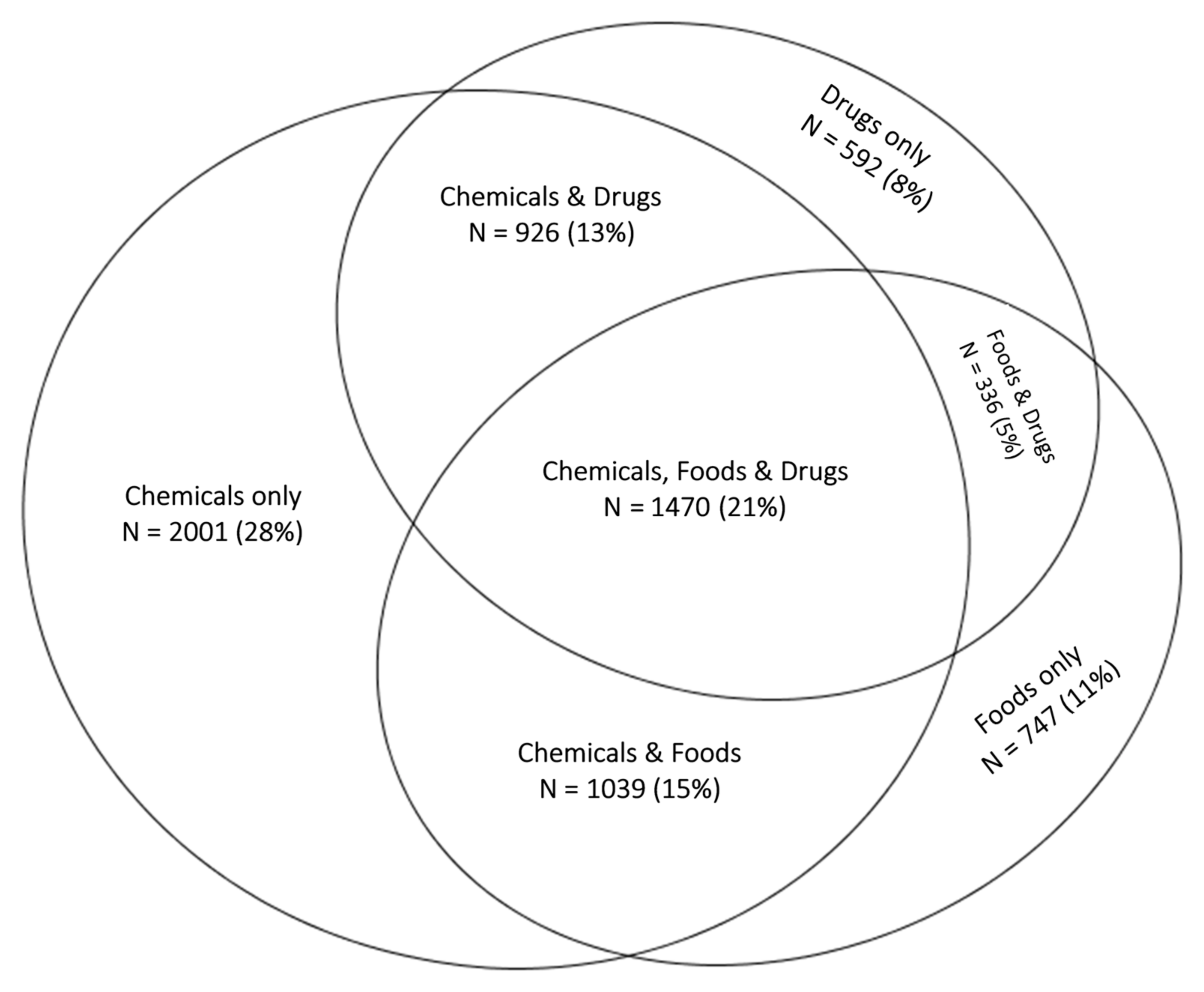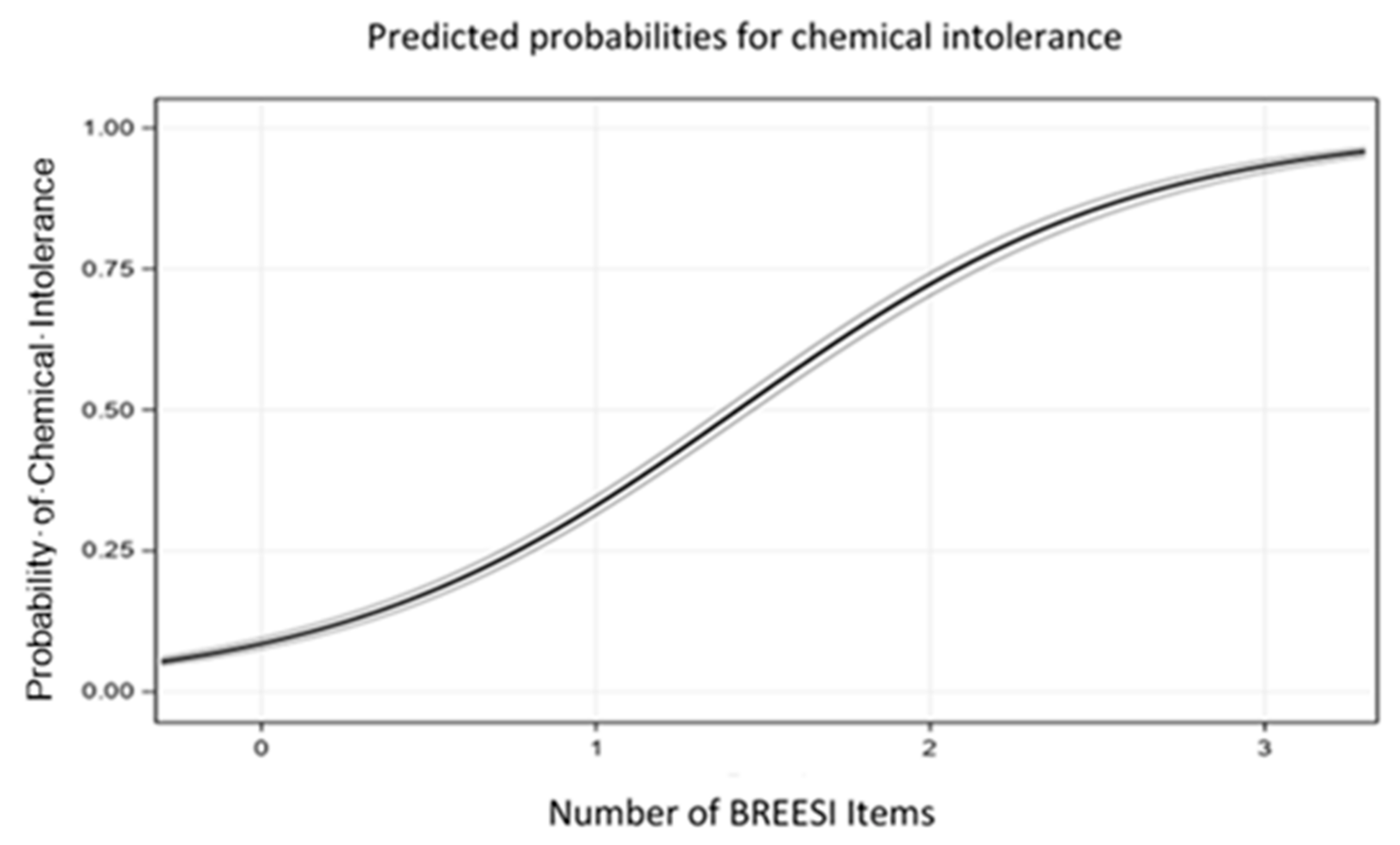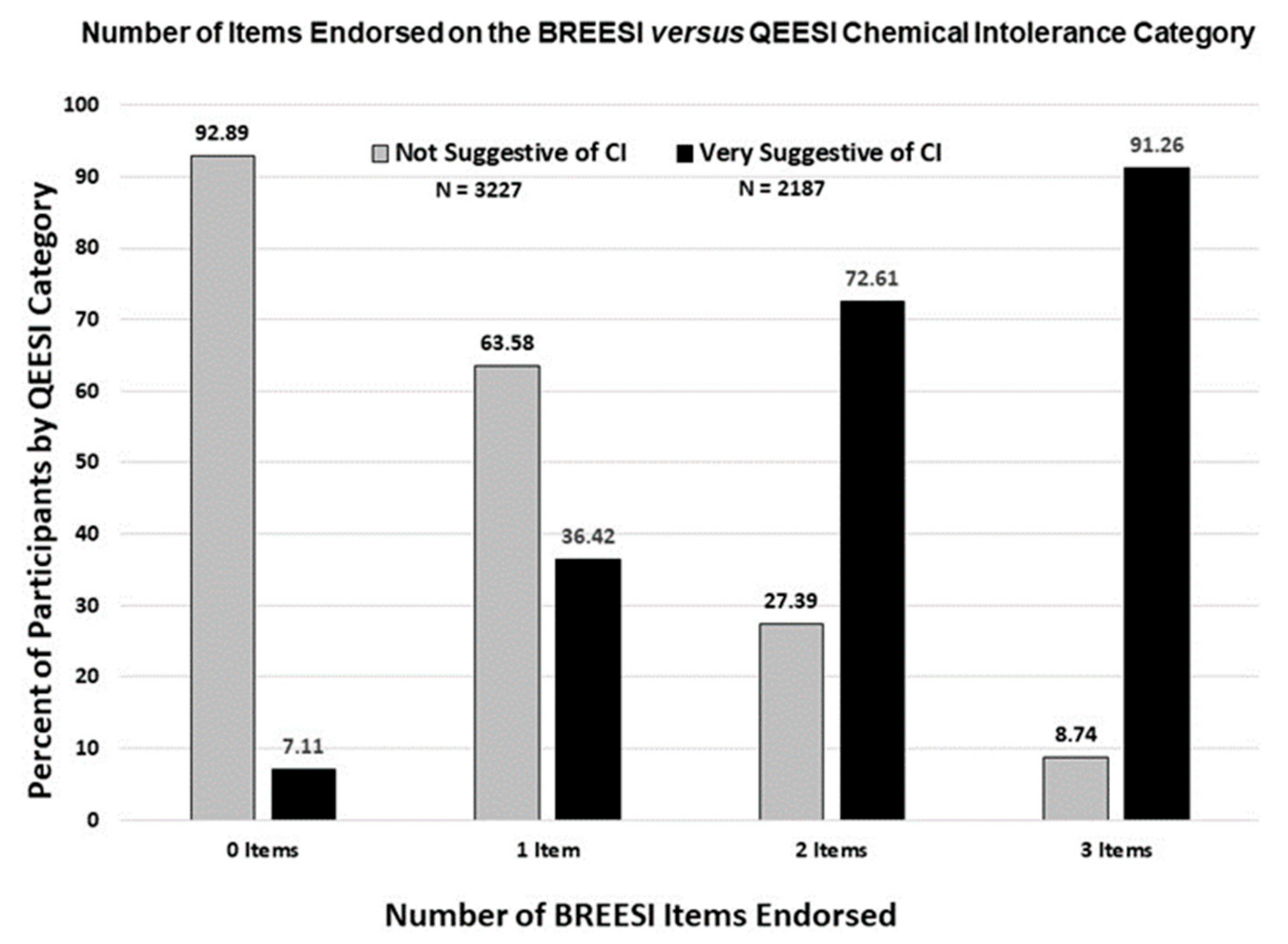Validation of a Brief Screening Instrument for Chemical Intolerance in a Large U.S. National Sample
Abstract
:1. Introduction
The Brief Environmental Exposure and Sensitivity Inventory (BREESI)
- Do you feel sick when you are exposed to tobacco smoke, certain fragrances, nail polish/remover, engine exhaust, gasoline, air fresheners, pesticides, paint/thinner, fresh tar/asphalt, cleaning supplies, new carpet, or furnishings? By sick, we mean headaches, difficulty thinking, difficulty breathing, weakness, dizziness, upset stomach, etc?_Yes _No
- Are you unable to tolerate or do you have adverse or allergic reactions to any drugs or medications (such as antibiotics, anesthetics, pain relievers, X-ray contrast dye, vaccines, or birth control pills) or to an implant, prosthesis, contraceptive chemical or device, or other medical/surgical/dental material or procedure?_Yes _No
- Are you unable to tolerate or do you have adverse reactions to any foods such as dairy products, wheat, corn, eggs, caffeine, alcoholic beverages, or food additives (such as MSG, food dye)?_Yes _No
2. Materials and Methods
- Positive likelihood ratio (PLR): the ratio between the probability of a positive test result given the presence of the disease and the probability of a positive test result given the absence of the disease.PLR = True positive rate/False positive rate = Sensitivity/(1-Specificity)
- Negative likelihood ratio (NLR): the ratio between the probability of a negative test result given the presence of the disease and the probability of a negative test result given the absence of the disease.NLR = False negative rate/True negative rate = (1-Sensitivity)/Specificity
3. Results
4. Discussion
5. Conclusions
Supplementary Materials
Author Contributions
Funding
Institutional Review Board Statement
Informed Consent Statement
Data Availability Statement
Acknowledgments
Conflicts of Interest
References
- Hojo, S.; Mizukoshi, A.; Azuma, K.; Okumura, J.; Ishikawa, S.; Miyata, M.; Mizuki, M.; Ogura, H.; Sakabe, K. Survey on changes in subjective symptoms, onset/trigger factors, allergic diseases, and chemical exposures in the past decade of Japanese patients with multiple chemical sensitivity. Int. J. Hyg. Environ. Health 2018, 221, 1085–1096. [Google Scholar] [CrossRef]
- Steinemann, A. National Prevalence and Effects of Multiple Chemical Sensitivities. J. Occup. Environ. Med. 2018, 60, e152–e156. [Google Scholar] [CrossRef] [PubMed] [Green Version]
- Young, E.; Stoneham, M.D.; Petruckevitch, A.; Barton, J.; Rona, R. A population study of food intolerance. Lancet 1994, 343, 1127–1130. [Google Scholar] [CrossRef]
- Rona, R.; Keil, T.; Summers, C.; Gislason, D.; Zuidmeer, L.; Sodergren, E.; Sigurdardottir, S.T.; Lindner, T.; Goldhahn, K.; Dahlstrom, J.; et al. The prevalence of food allergy: A meta-analysis. J. Allergy Clin. Immunol. 2007, 120, 638–646. [Google Scholar] [CrossRef] [PubMed]
- Macy, E. Multiple Drug Intolerance Syndrome. In Drug Allergy Testing; David, A.K., Banerji, A., Eds.; Elsevier: Amsterdam, The Netherlands, 2018; pp. 165–168. ISBN 9780323485517. [Google Scholar] [CrossRef]
- Caress, S.M.; Steinemann, A.C. Prevalence of multiple chemical sensitivities: A population-based study in the southeastern United States. Am. J. Public Health 2004, 94, 746–747. [Google Scholar] [CrossRef] [PubMed]
- Azuma, K.; Uchiyama, I.; Katoh, T.; Ogata, H.; Arashidani, K.; Kunugita, N. Prevalence and Characteristics of Chemical Intolerance: A Japanese Population-Based Study. Arch. Environ. Occup. Health 2015, 70, 341–353. [Google Scholar] [CrossRef] [PubMed]
- Kreutzer, R.; Neutra, R.R.; Lashuay, N. Prevalence of people reporting sensitivities to chemicals in a population-based survey. Am. J. Epidemiol. 1999, 150, 1–12. [Google Scholar] [CrossRef] [PubMed] [Green Version]
- Katerndahl, D.A.; Bell, I.R.; Palmer, R.F.; Miller, C.S. Chemical intolerance in primary care settings: Prevalence, comorbidity, and outcomes. Ann. Fam. Med. 2012, 10, 357–365. [Google Scholar] [CrossRef] [PubMed] [Green Version]
- Gupta, R.S.; Warren, C.M.; Smith, B.M.; Jiang, J.; Blumenstock, J.A.; Davis, M.M.; Schleimer, R.P.; Nadeau, K.C. Prevalence and Severity of Food Allergies Among US Adults. JAMA Netw. Open 2019, 2, e185630. [Google Scholar] [CrossRef] [PubMed]
- Rael, E.; Sampath, V.; Nadeau, K.C. Diagnosis and Differential Diagnosis of Food Allergy. In Pediatric Food Allergy; Gupta, R., Ed.; Springer: Berlin/Heidelberg, Germany, 2020. [Google Scholar] [CrossRef]
- Macy, E.; Ho, N.J. Multiple drug intolerance syndrome: Prevalence, clinical characteristics, and management. Ann. Allergy. Asthma Immunol. 2011, 108, 88–93. [Google Scholar] [CrossRef] [PubMed]
- Omer, H.M.; Hodson, J.; Thomas, S.K.; Coleman, J.J. Multiple drug intolerance syndrome: A large-scale retrospective study. Drug Saf. 2014, 37, 1037–1045. [Google Scholar] [CrossRef] [PubMed] [Green Version]
- Palmer, R.F.; Jaén, C.R.; Perales, R.B.; Rincon, R.; Forster, J.N.; Miller, C.S. Three questions for identifying chemically intolerant individuals in clinical and epidemiological populations: The Brief Environmental Exposure and Sensitivity Inventory (BREESI). PLoS ONE 2020, 15, e0238296. [Google Scholar] [CrossRef] [PubMed]
- SurveyMonkey Audience Platform. SurveyMonkey Inc. San Mateo, California, USA. Available online: www.surveymonkey.com (accessed on 13 August 2021).
- Miller, C.S.; Prihoda, T.J. The Environmental Exposure and Sensitivity Inventory (EESI): A standardized approach for measuring chemical intolerances for research and clinical applications. Toxicol. Ind. Health 1999, 15, 370–385. [Google Scholar] [CrossRef] [PubMed]
- Miller, C.S.; Prihoda, T.J. A controlled comparison of symptoms and chemical intolerances reported by Gulf War veterans, implant recipients and persons with multiple chemical sensitivity. Toxicol. Ind. Health 1999, 15, 386–397. [Google Scholar] [CrossRef] [PubMed]
- Maxim, L.D.; Niebo, R.; Utell, M.J. Screening tests: A review with examples. Inhal. Toxicol. 2014, 26, 811–828. [Google Scholar] [CrossRef] [PubMed]
- Altman, D.G.; Bland, J.M. Diagnostic tests 2: Predictive values. BMJ 1994, 309, 102. [Google Scholar] [CrossRef] [PubMed] [Green Version]
- Heston, T.F. Standardizing predictive values in diagnostic imaging research. J. Magn. Reson. Imaging 2011, 33, 505. [Google Scholar] [CrossRef] [PubMed]
- Zhou, X.H.; Obuchowski, N.A.; McClish, D.K. Statistical Methods in Diagnostic Medicine; Wiley: New York, NY, USA, 2002. [Google Scholar]
- Glen, S. Likelihood Ratio (Medicine): Basic Definition, Interpretation. From Statistics HowTo.com: Elementary Statistics for the Rest of Us! Available online: https://www.statisticshowto.com/likelihood-ratio/ (accessed on 13 August 2021).
- McGee, S. Simplifying Likelihood Ratios. J. Gen. Intern. Med. 2002, 17, 647–650. [Google Scholar] [CrossRef] [Green Version]
- SAS Institute Inc. SAS® 9.4 Statements: Reference, 3rd ed.; SAS Institute Inc.: Cary, NC, USA, 2014. [Google Scholar]
- U.S. Census Bureau. American Community Survey, 2019 American Community Survey Detailed Tables by Age and Sex, Table 1. Available online: https://data.census.gov/cedsci/ (accessed on 7 June 2021).
- United States Census Bureau. United States. Quick Facts. 2019. Available online: https://www.census.gov/quickfacts/fact/table/US/PST045219 (accessed on 1 November 2020).
- Fang, M.L.; Canham, S.L.; Battersby, L.; Sixsmith, J.; Wada, M.; Sixsmith, A. Exploring Privilege in the Digital Divide: Implications for Theory, Policy, and Practice. Gerontologist 2019, 59, e1–e15. [Google Scholar] [CrossRef] [PubMed]



| Country | Author & Date | N | Country | Author & Date | N |
|---|---|---|---|---|---|
| Austria | Weiss, 2017 | 72 | Japan | Hojo, 2009 | 412 |
| China | Huang, 2011 | 658 | Japan | Hojo, 2018 | 214 |
| China | Huang, 2014 | 658 | Japan | Hojo, 2019 | 555 |
| Columbia | Storino, 2021 | 1 | Japan | Ishibashi, 2007 | 214 |
| Denmark | Dantoft, 2014 | 298 | Japan | Lu, 2020 | 667 |
| Denmark | Hauge, 2015 | 69 | Japan | Manabe, 2008 | 368 |
| Denmark | Skovbjerg, 2012 | 1493 | Japan | Mizuki, 2004 | 32 |
| Denmark | Tran, 2014 | 3 | Japan | Mizuki, 2015 | 40 |
| Denmark | Tran, 2017 | 39 | Japan | Mizukoshi, 2015 | 8 |
| Finland | Heinonen-Guzejev, 2012 | 327 | Japan | Nakaoka, 2018 | 43 |
| Finland | Selinheimo, 2019 | 52 | Japan | Ohsawa, 2020 | 2 |
| Finland | Vuokko, 2019 | 12 | Japan | Suzuki, 2020 | 141 |
| France | Kamoun, 2011 | 20 | Japan | Watai, 2018 | 528 |
| Germany | Bauer, 2007 | 202 | Japan | Yoshino, 2004 | 69 |
| Germany | Schnakenberg, 2007 | 521 | Saudi Arabia | Khalil, 2020 | 134 |
| Indonesia | Hildebrandt, 2019 | 471 | South Korea | Heo, 2017 | 1030 |
| Indonesia | Kubota,2020 | 707 | South Korea | Jeon, 2012 | 300 |
| Italy | Caccamo, 2013 | 443 | South Korea | Jeong, 2014 | 379 |
| Italy | De Luca, 2010 | 444 | South Korea | Yun, 2013 | 1 |
| Italy | De Luca, 2014 | 300 | Spain | Aguilar-Aguilar, 2018 | 52 |
| Italy | De Luca, 2015 | 563 | Spain | Alobid, 2014 | 118 |
| Italy | Gugliandolo, 2016 | 34 | Spain | Fernandez-Solà, 2005 | 75 |
| Italy | Micarelli, 2016a | 38 | Spain | García-Sierra, 2014 | 125 |
| Italy | Micarelli, 2016b | 38 | Spain | Lago Blanco, 2016 | 73 |
| Italy | Viziano, 2017 | 38 | Spain | Mena, 2013 | 231 |
| Japan | Azuma, 2013 | 23 | Spain | Nogué, 2007 | 52 |
| Japan | Azuma, 2015a | 7245 | Spain | Paredes-Rizo, 2018 | 1 |
| Japan | Azuma, 2015b | 12 | Spain | Pérez-Crespo, 2018 | 514 |
| Japan | Azuma, 2016 | 16 | Spain | Aguilar-Aguilar, 2018 | 52 |
| Japan | Azuma, 2019 | 909 | Sweden | Andersson, 2009 | 207 |
| Japan | Cui, 2013 | 324 | Sweden | Nordin, 2010 | 283 |
| Japan | Cui, 2014 | 2464 | United States | Gould Peek, 2015 | 563 |
| Japan | Cui, 2015 | 565 | United States | Heilbrun, 2015 | 694 |
| Japan | Fujimori, 2012 | 1084 | United States | Katerndahl, 2012 | 400 |
| Japan | Hasegawa, 2009 | 51 | United States | Miller, 1999a | 421 |
| Japan | Hojo, 2002 | 1260 | United States | Miller, 1999b | 421 |
| Japan | Hojo, 2003 | 760 | United States | Palmer, 2020 | 293 |
| Japan | Hojo, 2005 | 440 | Uruguay | De Ben, 2014 | 2 |
| Japan | Hojo, 2008 | 106 | 16 Countries Total N > 32,000 subjects | ||
| N | Percentage of Sample | Percentage in ACS | ||
|---|---|---|---|---|
| Gender | Male | 4927 | 53.36% | 48.68% |
| Female | 5636 | 46.64% | 51.32% | |
| Missing | 161 | 1.50% | ||
| Age | ||||
| 18–29 | 2788 | 26.39% | 13.10% | |
| 30–44 | 2320 | 21.96% | 27.69% | |
| 45–60 | 3143 | 29.75% | 26.87% | |
| >60 | 2312 | 21.89% | 32.34% | |
| Missing | 161 | 1.50% | ||
| Household Income/Year | ||||
| <$25,000 | 1839 | 17.45% | 18.1% | |
| $25,000–$49,999 | 2018 | 19.15% | 20.3% | |
| $50,000–$74,999 | 1965 | 18.65% | 17.4% | |
| $75,000–$99,999 | 1358 | 12.89% | 12.8% | |
| ≥$100,000 | 2341 | 22.21% | 31.4% | |
| Prefer not to answer | 1018 | 9.66% | ||
| Missing | 185 | 1.7% | ||
| QEESI Score | ||||
| Not Suggestive of CI | 3227 | 30.09% | NA | |
| Suggestive of CI | 5310 | 49.52% | NA | |
| Very Suggestive of CI | 2187 | 20.39% | NA | |
| Number of BREESI Items Endorsed | ||||
| 0 | 3614 | 33.7% | NA | |
| 1 | 3320 | 30.96% | NA | |
| 2 | 2311 | 21.55% | NA | |
| 3 | 1479 | 13.79% | NA | |
| Not Suggestive of CI | Suggestive of CI | Very Suggestive of CI | ||
|---|---|---|---|---|
| Total Sample | 30.09% | 49.52% | 20.39% | |
| Gender | Male | 36.76% | 45.04% | 18.21% |
| Female | 23.94% | 53.46% | 22.6% *** | |
| Age | 18–29 | 26.72% | 49.28% | 24.00% |
| 30–44 | 26.9% | 49.83% | 23.28% | |
| 45–60 | 27.39% | 50.30% | 22.3% | |
| >60 | 40.22% | 48.49% | 11.29% *** | |
| Household Income/Year | ||||
| <25,000 | 27.35% | 47.85% | 24.8% | |
| $25,000–<$50,000 | 25.82% | 51.34% | 22.84% | |
| $50,000–<$75,000 | 27.94% | 50.08% | 21.98% | |
| $75,000–<$100,000 | 29.68% | 49.63% | 20.69% | |
| >$100,000 | 34.39% | 48.83% | 16.79% *** | |
| Prefer not to answer | 36.25% | 49.41% | 14.34% | |
| QEESI Scale Scores | Total | Not Suggestive of CI | Suggestive of CI | Very Suggestive of CI |
| Mean (SD) | Mean (SD) | Mean (SD) | Mean (SD) | |
| Chemical Exposures Score | 28.50 (22.49) | 6.10 (5.90) | 29.91 (16.12) | 58.14 (13.17) *** |
| Symptom Score | 28.58 (22.10) | 6.97 (5.94) | 29.34 (15.13) | 58.64 (13.56) *** |
| Value | 95% Confidence Interval | |
|---|---|---|
| United States sample (n = 10,724) | ||
| Sensitivity | 91.26% | 89.20% to 93.04% |
| Specificity | 92.89% | 91.77% to 93.90% |
| Positive Predictive Value | 82.89% | 80.68% to 84.89% |
| Negative Predictive Value | 96.57% | 95.79% to 97.21% |
| Positive Likelihood Ratio | 12.83 | 11.07 to 14.88 |
| Negative Likelihood Ratio | 0.09 | 0.08 to 0.12 |
| Accuracy | 92.44% | 91.47% to 93.33% |
| Additional United States Sensitivity sample (N = 1000) | ||
| Sensitivity | 78.71% | 71.42% to 84.87% |
| Specificity | 97.28% | 93.18% to 99.25% |
| Positive Predictive Value | 92.85% | 83.13% to 97.17% |
| Negative Predictive Value | 91.05% | 88.24% to 93.23% |
| Positive Likelihood Ratio | 28.93 | 10.96 to 76.31 |
| Negative Likelihood Ratio | 0.22 | 0.16 to 0.30 |
| Accuracy | 91.52% | 87.79% to 94.41% |
Publisher’s Note: MDPI stays neutral with regard to jurisdictional claims in published maps and institutional affiliations. |
© 2021 by the authors. Licensee MDPI, Basel, Switzerland. This article is an open access article distributed under the terms and conditions of the Creative Commons Attribution (CC BY) license (https://creativecommons.org/licenses/by/4.0/).
Share and Cite
Palmer, R.F.; Walker, T.; Kattari, D.; Rincon, R.; Perales, R.B.; Jaén, C.R.; Grimes, C.; Sundblad, D.R.; Miller, C.S. Validation of a Brief Screening Instrument for Chemical Intolerance in a Large U.S. National Sample. Int. J. Environ. Res. Public Health 2021, 18, 8714. https://doi.org/10.3390/ijerph18168714
Palmer RF, Walker T, Kattari D, Rincon R, Perales RB, Jaén CR, Grimes C, Sundblad DR, Miller CS. Validation of a Brief Screening Instrument for Chemical Intolerance in a Large U.S. National Sample. International Journal of Environmental Research and Public Health. 2021; 18(16):8714. https://doi.org/10.3390/ijerph18168714
Chicago/Turabian StylePalmer, Raymond F., Tatjana Walker, David Kattari, Rudy Rincon, Roger B. Perales, Carlos R. Jaén, Carl Grimes, Dana R. Sundblad, and Claudia S. Miller. 2021. "Validation of a Brief Screening Instrument for Chemical Intolerance in a Large U.S. National Sample" International Journal of Environmental Research and Public Health 18, no. 16: 8714. https://doi.org/10.3390/ijerph18168714
APA StylePalmer, R. F., Walker, T., Kattari, D., Rincon, R., Perales, R. B., Jaén, C. R., Grimes, C., Sundblad, D. R., & Miller, C. S. (2021). Validation of a Brief Screening Instrument for Chemical Intolerance in a Large U.S. National Sample. International Journal of Environmental Research and Public Health, 18(16), 8714. https://doi.org/10.3390/ijerph18168714






